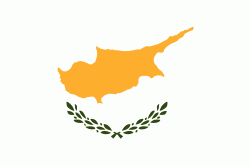Flag of Cyprus
The national flag of Cyprus (Σημαία της Κύπρου; Kıbrıs bayrağı) came into use on 16 August 1960, under the Zürich and London Agreements, whereby a constitution was drafted and Cyprus was proclaimed an independent state. The flag was designed by artist İsmet Güney. The design of the flag deliberately employs peaceful and neutral symbols in an attempt to indicate harmony between the Greek and Turkish Cypriot communities, an ideal that has not yet been realised. In 1963, Greek Cypriot and Turkish Cypriot communities separated because of Cypriot intercommunal violence.
The national flag features the shape of the entirety of the island, with two olive branches below (a symbol of peace between the island's two communities) on white (another symbol of peace). The olive branches signify peace between the Greek and Turkish Cypriots. The map on the flag is a copper-orange colour, symbolising the large deposits of copper ore on the island, from which it may have received its name.
The flag of the Republic of Cyprus was preceded by the flag of British Cyprus. Upon independence, Cyprus adopted a new flag. Under the constitution, the flag should “have a neutral design and colour,” i.e. it should not include either blue or red colours (the colours of the flag of Greece and the flag of Turkey), nor portray a cross or a crescent.
The original proposal, made by the former British colonial administration, featured a rust-brown K on a white field. It was rejected by the President Makarios III and Vice-president Fazil Küçük, who preferred a flag proposed by İsmet Güney, a Turkish Cypriot artist.
In the design of August 1960, the colour of the map is copper (Pantone 144-C). Both the crest and the two olive-tree leaves are olive green (Pantone 336-C). The background is white with the 3:5 ratio. In April 2006 the design was updated, the shape of the olive branches were slightly altered, its color was changed to Pantone 574, The copper color of the map was changed to Pantone 1385 and the ratio was changed to 3:2.
Flags produced on Cyprus often differ from the original specifications, both regarding the size of the map and the colours used. The government announced in October 2005, that it would take steps to "start from scratch" and assure that only flags complying with the official specifications would be produced.
Under the constitution of Cyprus, the flag of Cyprus may be flown by state institutions, public corporations, and citizens of the country.
The national flag features the shape of the entirety of the island, with two olive branches below (a symbol of peace between the island's two communities) on white (another symbol of peace). The olive branches signify peace between the Greek and Turkish Cypriots. The map on the flag is a copper-orange colour, symbolising the large deposits of copper ore on the island, from which it may have received its name.
The flag of the Republic of Cyprus was preceded by the flag of British Cyprus. Upon independence, Cyprus adopted a new flag. Under the constitution, the flag should “have a neutral design and colour,” i.e. it should not include either blue or red colours (the colours of the flag of Greece and the flag of Turkey), nor portray a cross or a crescent.
The original proposal, made by the former British colonial administration, featured a rust-brown K on a white field. It was rejected by the President Makarios III and Vice-president Fazil Küçük, who preferred a flag proposed by İsmet Güney, a Turkish Cypriot artist.
In the design of August 1960, the colour of the map is copper (Pantone 144-C). Both the crest and the two olive-tree leaves are olive green (Pantone 336-C). The background is white with the 3:5 ratio. In April 2006 the design was updated, the shape of the olive branches were slightly altered, its color was changed to Pantone 574, The copper color of the map was changed to Pantone 1385 and the ratio was changed to 3:2.
Flags produced on Cyprus often differ from the original specifications, both regarding the size of the map and the colours used. The government announced in October 2005, that it would take steps to "start from scratch" and assure that only flags complying with the official specifications would be produced.
Under the constitution of Cyprus, the flag of Cyprus may be flown by state institutions, public corporations, and citizens of the country.
National flag
Country - Cyprus
Warning: getimagesize(/Image/Map/MP146669.gif): failed to open stream: No such file or directory in /home/mapnlee7/public_html/MAPNALL/article.php on line 532
 |
 |
The earliest known human activity on the island dates to around the 10th millennium BC. Archaeological remains include the well-preserved ruins from the Hellenistic period such as Salamis and Kourion, and Cyprus is home to some of the oldest water wells in the world. Cyprus was settled by Mycenaean Greeks in two waves in the 2nd millennium BC. As a strategic location in the Eastern Mediterranean, it was subsequently occupied by several major powers, including the empires of the Assyrians, Egyptians and Persians, from whom the island was seized in 333 BC by Alexander the Great. Subsequent rule by Ptolemaic Egypt, the Classical and Eastern Roman Empire, Arab caliphates for a short period, the French Lusignan dynasty and the Venetians was followed by over three centuries of Ottoman rule between 1571 and 1878 (de jure until 1914).
